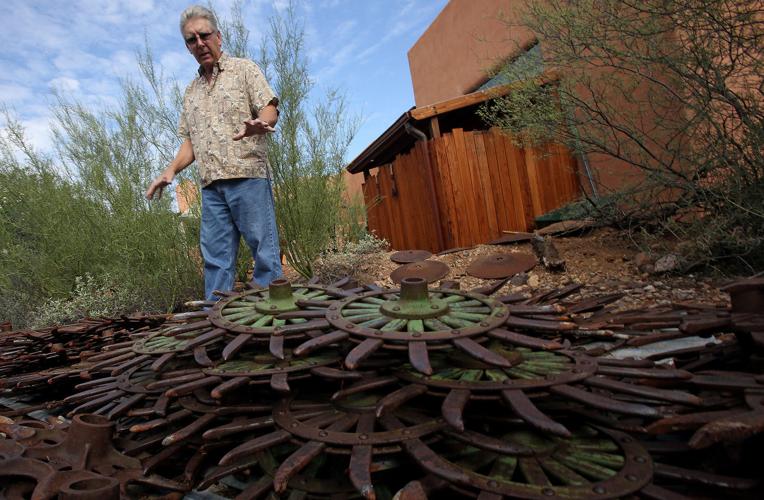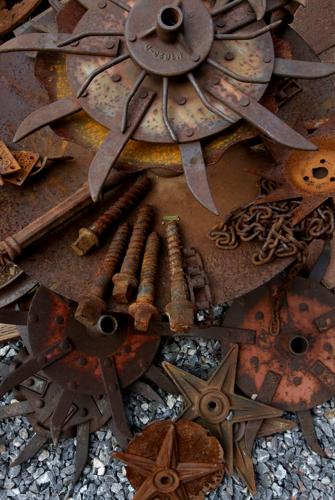In the winter dark and summer dawn, a score of artists converge on a scrap yard in south Tucson to find inspiration.
Tucson Iron & Metal calls the twice -monthly, early-morning gathering its Artist’s Paradise. Under company supervision, artists are allowed “into the back” of the yard before the recycling center opens for business, says Martin Martinez, the company’s retail sales manager.
From 6:30 to 8 a.m., artists scrounge through ever-changing piles of steel, aluminum, iron and other metal discards from manufacturing companies, mines, government agencies and other sources.
“Everything we get is just amazing in an artist’s point of view,” says Martinez, himself a casual collector of art.
“It’s fun to just poke around,” says artist and landscape designer Greg Corman. “It’s the hunt that gets you motivated.”
Over the years, a small group of artists grew close. They help each other find material in the scrap yard and share information about Tucson’s growing metal-arts scene.
“We evolved into this wonderful community of people,” Corman says.
Last spring that community put on a show in Tucson Iron & Metal’s parking lot. It is debuting its fall edition on Sunday.
The title of the show, FeST, is a play on the chemical term for the element iron (Fe).
“We do it for the appreciation of our customers,” says Martinez. “It makes me feel really good to see something that beautiful come out of this yard.”
As many as 20 artists will participate in the show, says Corman, including these two whose works focus on outdoor and garden art.
FARM EQUIPMENT
Richard Jones still doesn’t consider himself an artist. He calls himself a collector who sells art to feed his “addiction” to old farming equipment.
Jones started making art a year ago, when he was 70 years old. He came upon a rotary hoe wheel in an antique store. It looks like a radiating sun or sunflower blossom.
He bought that one to frame. Then he bought more of them, drawn by their different appearances based on their purpose and manufacturer.
A self-described “city boy,” Jones has used this growing collection to learn farming history. The oldest wheel he owns was manufactured in 1919 and he has many from the 1930s.
To show off his wheels, Jones started framing them as patio artworks. That led to adding corrugated steel backings to some, barbed wire backings to others and a host of metal embellishments.
He’s also started turning farm disks, which are shaped like shallow, handleless woks, as well as straw bale spears and seed plates, into art pieces.
“This was supposed to be a hobby,” he says. “Now I don’t have enough room to hang them.
“It was necessary to sell them to support my addiction.”
Jones rarely finds farm equipment at Tucson Iron & Metal, but he buys items there that help him build his pieces.
For instance, he turned a plow disk into a gong using a tripod, chain and a grinding ball that he found at the scrap yard. It’s topped with a metal University of Arizona “A.”
“I’m always looking for things that I can use,” he says.
RUSTY CREATURES
Tucson native Everett Grondin has been creating art with recycled material since he was preschool-aged, when he glued discarded costume gems onto egg shells for his grandmother to sell as Faberge-style trinkets.
That experience, plus growing up on a Marana farm where his dad “did all our metal work,” led Grondin to work as a metal fabricator.
His bread and butter is building decorative gates, trellises, fencing and other functional outdoor features.
But he loves taking what he can find at scrap yards and elsewhere to make sculptures and functional art. “I’m just doing it because I like it,” he says.
He found old yellow street signs that say “Cattle Guard” and “Unknown Conditions Ahead” at Tucson Iron & Metal. He put them on top of table bases from the closed El Parador Restaurant to create unusual café tables.
He used lawn mower blades for the ribs of a five-foot-long fish fossil sculpture. Industrial chain is turned into snakes. Horny toads emerge from a collection of shovels, rakes, chain saws, hooks and punched metal shaped as diamonds.
Grondin spends a lot of his time at the scrap yard searching for fire extinguisher canisters, which he turns into outdoor bells.
While Grondin has easy access to new metal, he likes the rusty look of used metal. Plus, the unusual pieces he finds at the scrap yard spur his imagination.
Which is why he admits he’s an “addict” when it comes to the Artist’s Paradise.
He talks of a weekend when he partied late Friday night and had someplace to go Saturday afternoon. “I could have missed that morning,” he says of the Artist’s Paradise scheduled that Saturday. Yet he got up to get to Tucson Iron & Metal when the gate opened at 6:30 a.m.
“I hate to miss a day,” he says, “because you don’t know what you’re going to miss.”







